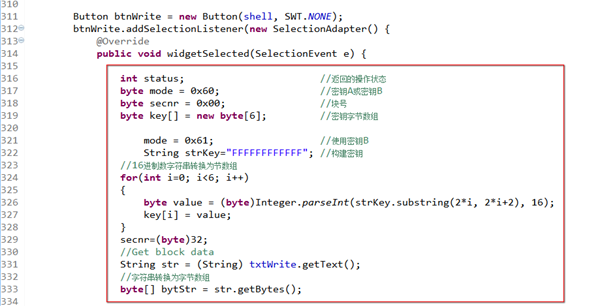实训四飞利浦S50卡数据块读写编程实训
实训四飞利浦S50卡数据块读写编程实训
一、实训目的
1、掌握JAVA引用外部DLL文件的编程方法。
2、掌握RFID读写器读取存储器块数据的编程方法。
3、掌握RFID读写器写入存储器块数据的编程方法。
二、实训设备
1、笔记本电脑,Win7或Win10操作系统,JDK+Eclipse+WindowBuilder软件开发环境。
2、BC750AS RFID读写器,MF1 空白卡。
三、实训内容和步骤
1、新建项目
进入Eclipse后,单击菜单“文件--新建--项目…”,或在起始页中单击“新建项目…”,打开新建项目窗口,选择“WindowBuilder—SWT Designer—SWT/JFace Java Project”,然后单击下一步,输入项目名称:MF1Card_RwTest20160211XX,选择保存位置,然后单击“确定”按钮。
2、新建应用程序窗口
选中新建项目中的“src”,单击菜单“文件—新建—其他…”,打开“新建”对话框,选择“SWT—Application Window”,单击“下一步”,打开“New SWT Application”对话框。

3、设计程序界面
从解决方案资源管理器窗口中双击“Form1.cs”,打开Form1.cs[设计]界面,先修改Form1的标题为“MF1Card_RWTest 16物联网1班 xxx 20160211xx”,然后从工具箱中拖放控件:2个标签(label),4个文本框(text)和4个按钮(button),修改控件的名称和显示的文本(text),进行适当的布局调整。

4、拷贝外部DLL文件和库文件夹(lib)
将外部DLL文件(BcHidDevice.dll和hfrdapi.dll)拷贝到项目文件夹中的“bin”目录下。
将库文件夹(lib)拷贝到实训项目的根文件夹中。
5、编写代码
(1)编写导入外部DLL和公用函数的代码,参照下图所示,将后面给出的源代码拷贝到正确的位置。


复制引用外部DLL的代码段:
//Load DLL Library
public interface ReaderLib extends StdCallLibrary
{
ReaderLib INSTANCE = (ReaderLib)Native.loadLibrary("hfrdapi",ReaderLib.class);
int Sys_Open(int[] device, int index, short vid, short pid);
int Sys_Close(int[] device);
boolean Sys_IsOpen(int device);
int Sys_SetLight(int device, byte color);
int Sys_SetBuzzer(int device, byte msec);
int Sys_SetAntenna(int device, byte mode);
int Sys_InitType(int device, byte type);
int TyA_Request(int device, byte mode , short[] pTagType);
int TyA_Anticollision(int device, byte bcnt, byte[] pSnr, byte[] pLen);
int TyA_Select(int device, byte[] pSnr, byte snrLen, byte[] pSak);
int TyA_Halt(int device);
int TyA_CS_Authentication2(int device, byte mode, byte block, byte[] pKey);
int TyA_CS_Read(int device, byte block, byte[] pData, byte[] pLen);
int TyA_CS_Write(int device, byte block, byte[] pData);
int TyA_UID_Write(int device, byte[] pData);
}
(2)编写“打开”按钮的单击事件程序






复制打开按钮的单击事件程序
int status;
boolean bStatus;
//=================== Connect the reader ===================
//Check whether the reader is connected or not
//If the reader is already open , close it firstly
bStatus = ReaderLib.INSTANCE.Sys_IsOpen(g_hDevice[0]); //判断是否已打开?
if(bStatus == true)
{
status = ReaderLib.INSTANCE.Sys_Close(g_hDevice); //如果已打开,则先关闭
if(status != 0)
{
lblTips.setText("Sys_Close failed !"); //如果关闭失败,则报错
return;
}
}
//Connect
status = ReaderLib.INSTANCE.Sys_Open(g_hDevice, 0, (short)0x0416, (short)0x8020);
if(status != 0)
{
lblTips.setText("Sys_Open failed !");
return;
}
//========== Init the reader before operating the card ==========
//Close antenna of the reader
status = ReaderLib.INSTANCE.Sys_SetAntenna(g_hDevice[0], (byte)0);
if(status != 0)
{
lblTips.setText("Sys_SetAntenna failed !");
return;
}
//Appropriate delay after Sys_SetAntenna operating
try { Thread.sleep(5); }
catch (Exception e1) { }
//Set the reader's working mode
status = ReaderLib.INSTANCE.Sys_InitType(g_hDevice[0], (byte)'A');
if(status != 0)
{
lblTips.setText("Sys_InitType failed !");
return;
}
//Appropriate delay after Sys_SetAntenna operating
try { Thread.sleep(5); }
catch (Exception e2) { }
//Open antenna of the reader
status = ReaderLib.INSTANCE.Sys_SetAntenna(g_hDevice[0], (byte)1);
if(status != 0)
{
lblTips.setText("Sys_SetAntenna failed !");
return;
}
//Appropriate delay after Sys_SetAntenna operating
try { Thread.sleep(5); }
catch (Exception e3) { }
//==================== Success Tips ====================
//Beep 200 ms
status = ReaderLib.INSTANCE.Sys_SetBuzzer(g_hDevice[0], (byte)20);
if(status != 0)
{
lblTips.setText("Sys_SetBuzzer failed !");
return;
}
//Tips
lblTips.setText("Connect reader succeed !");
(3)编写“寻卡”按钮的单击事件程序



复制寻卡按钮单击事件程序
int status;
byte mode = 0x52;
short[] TagType = new short[1];
byte bcnt = 0;
byte snr[] = new byte[16];
byte len[] = new byte[1];
byte sak[] = new byte[1];
//Check whether the reader is connected or not
if(false == ReaderLib.INSTANCE.Sys_IsOpen(g_hDevice[0]))
{
lblTips.setText("Please connect the device firstly !");
return ;
}
txtCardNo.setText("");
//Request card
status = ReaderLib.INSTANCE.TyA_Request(g_hDevice[0], mode, TagType);//search all card
if(status != 0)
{
lblTips.setText("TyA_Request failed !");
return ;
}
//Anticollision
status = ReaderLib.INSTANCE.TyA_Anticollision(g_hDevice[0], bcnt, snr, len);//return serial number of card
if(status != 0 || len[0] != 4)
{
lblTips.setText("TyA_Anticollision failed !");
return ;
}
String str="";
for(int i=0; i<4; i++)
{
str = str + String.format("%02X", snr[i]);
}
txtCardNo.setText(str);
//Select card
status = ReaderLib.INSTANCE.TyA_Select(g_hDevice[0], snr, len[0], sak);//lock ISO14443-3 TYPE_A
if(status != 0)
{
lblTips.setText("TyA_Select failed !");
return ;
}
//Tips
lblTips.setText("Request card succeed !");
(4)编写读数据按钮单击事件程序




(5)编写“写数据”按钮单击事件代码:



5、运行调试
(1)将BC750AS RFID读写器接入电脑的USB接口,蜂鸣器响一声,说明USB连接正确。
(2)录入编辑完成后,单击工具栏中的“启动”按钮,测试各个按钮的功能,检查程序的运行情况。

6、将编写、调试完成的源程序(解决方案)压缩为MF1Card_RWTest20160211XX.rar,作为实训题的附件上传。
四、实训总结
1、简述本次实训的收获
2、在导入外部DLL时,DLL文件需要拷贝到项目文件夹的哪个目录中。





 浙公网安备 33010602011771号
浙公网安备 33010602011771号